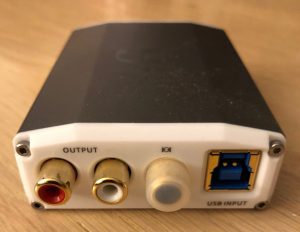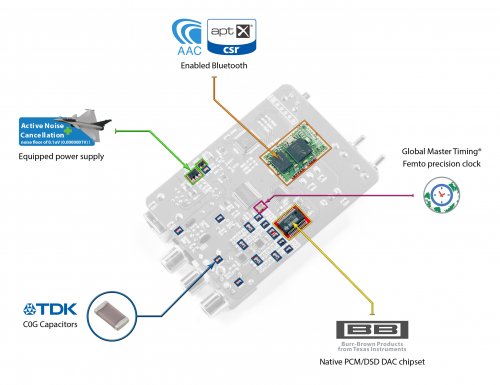ifi iOne DAC / Bluetooth Receiver
I have been looking for a small bluetooth DAC for a bedroom setup for some time and had narrowed the search down to a handful of possible models. About that same time, I was reviewing the xDSD and had a conversation with Lawrence the Ifi rep about if they ever had show gear that went on-sale as open box. As luck would have it, they do occasionally sell open-box items and I was able to purchase the iOne for about 3/4 of the normal asking price. What is written below are my thoughts after using the iOne for a month in my new bedroom setup. The complete setup is the iOne DAC, Burson Fun/Bang as headphone and Speaker Amps, KEF R300s Speakers, and HifiMan Edition S headphones. (I am admittedly looking for a better set of closed cans with an eye toward the Audeze LCD2C).
Packaging:
The iOne arrived in the typical slip cover style white box with all the details shown in full color as is typical of all Ifi packages I have received. Inside the box was the iOne on the top layer, and a pair of fairly short purple RCA Cables, a blue USB Cable, a power cable, a set of feet, a Toslink to mini-toslink adapter, the manual, and the warranty card hiding underneath. The kit is fairly complete in that all the cables you might need with the exception of a Toslink cable are thrown in, but all are on the short side so unless you want to perch the iOne immediately on top of your computer, you may want a longer USB cable.

Build:
The iOne is lightweight with the same shell shape as ifi uses for the Nano and Micro line but uses a plastic front and rear plate. The plastic is heavy enough that longevity isnt a concern unless abused. According to ifi, the windows in the sides of the metal case and the plastic front and rear were added to help in bluetooth reception and not just for aesthetic reasons. Also true to form, controls and indicators are all on the front of the unit while connections are all on the rear with information about the box specs, switches, etc is printed on the underside.


The front panel from left to right has the pairing button, an LED indicator, the 3 position input source switch (Bluetooth, USB, Spdif), and the 2 position filter switch (Listen and Measure). The LED indicator is a nice touch as it changes color depending on source type and file type being played. It takes a little time to familiarize yourself with all the possible color combinations but is a nice touch. The rear panel from left to right, has the RCA outputs, the Spdif input, and the USB 3 input. The Spdif input has a cover over it which is a nice touch to keep dust etc. out of the connection when not in use.



Internals:
The iOne uses a Ti/Burr Brown 1793DSD chip at its heart which provides support for PCM (44.1-192kHz), DSD (2.8-12.4MHz) and DXD (352/384kHz). Power is provided through the USB interface and an adapter is provided for use as a bluetooth device or SPDIF as no external power connector is present. USB Input is handled by the latest generation of XMOS.


Operations:
For sake of clarity, I am going to split up the operations discussion by input types. The switch for input is bluetooth in top position, Usb in middle, and spdif at bottom so we will go in that order here.
Bluetooth:
Pairing is straight forward and painless. Press the large button on the front left to put the device in pairing mode, the LED indicator blinks to let you know when in pairing mode and when pairing succeeds. Pairing is a quick process making device switching easy. My wife and I have used the iOne with Android, I-phone, I-pad, and Windows devices without a hiccup. Range is better than average with distances of 40-50 feet possible when line of sight can be maintained. A single interior wall does little to defeat the signal but once multiple walls obstruct the path signal is weak at best and frequently lost. The iOne supports AptX and AAC encoding (for Ios Devices) but not aptX-HD.
USB:
The iOne uses a USB 3.0 type connector and comes with a short cable (18 inches or so) to connect it to a source. While I apprecaite the fact that the cable was included, it was not long enough to work in any of my installs so I first tried a USB 2.0 type B cable which didn’t work. The iOne requires a 3.0 Cable. So, off to the web to find a USB 3.0 type A to type B cable with a bit more length. The Amazon Basics 9ft cable was $6 and works perfectly so not a big expense, but if you are interested in the iOne I recommend purchasing the cable at the same time so they arrive together rather than having to wait to try it out.
SPDIF:
The SPDIF connector on the iOne is the most versatile connector on the box. In input mode, it can be used for coax or optical inputs and a mini-toslink adapter is provided for use with optical cables. I had no problems using the iOne with the Coax output or the optical output from my PC sound card for the purpose of testing. The other option is when using USB or BT input, the SPDIF can be used as a coaxial output for PCM format up to 192kHz.
So, when used with bluetooth or USB input you have RCA output or Coax output, when used Coax or Optical inputs, only RCA outputs are available.
Sound:
Reviewing the sound of a DAC is a tough job. In a perfect world, it wouldn’t contribute to the sound and for the most part, the iOne does a good job of that. With its high precision clocking, active noise cancellation, and DSD support, the iOne packs a lot of punch for $200. Unfortunately, Bluetooth is not able to take advantage of all those things as well as the USB or SPDIF inputs and sound quality takes a notable hit when using bluetooth. Still, having the ability to stream Qubuz, Tidal, or Spotify to it is a nice option and when using standard resolution streams, the bluetooth interface is plenty good enough. I really couldnt tell much difference in the bluetooth input until I started working with DSD files and then the resolution differences were notable.
The Filters on the iOne are the same as those seen on the Nano and Micro product lines. Most will find that when set on listen the iOne is slightly brighter than when set on measure.
Conclusions:
I bought the iOne as an in-expensive option to have bluetooth input for a bedroom setup and am very pleased with it in that role. Having said that, I have used the iOne as a USB DAC paired with my Valhalla and Beyer 990s and with the Burson Fun Paired with the Hifiman/Massdrop 4xx and think one could live with the iOne as a primary DAC in a budget system and get a lot of bang for the buck. Sound quality is good and file format support is excellent and getting better with firmware updates as most Ifi products including the iOne are now MQA capable as well. Some will prefer the Micro or Nano line for the addition of a headphone amp and battery for portable use, others like myself that are looking for a solid DAC with good features for use at home or office without spending a fortune should take a good look at the iOne. It might be the One for you.



![DSC_1409[1].jpg DSC_1409[1].jpg](https://cdn.head-fi.org/a/10073642_thumb.jpg)

![DSC_1418[1].jpg DSC_1418[1].jpg](https://cdn.head-fi.org/a/10073645_thumb.jpg)
![DSC_1420[1].jpg DSC_1420[1].jpg](https://cdn.head-fi.org/a/10073646_thumb.jpg)
![DSC_1430[1].jpg DSC_1430[1].jpg](https://cdn.head-fi.org/a/10073651_thumb.jpg)
![DSC_1428[1].jpg DSC_1428[1].jpg](https://cdn.head-fi.org/a/10073652_thumb.jpg)









We do also have one downstairs upping the odds on the TV set-up. Using that and a NAD amp with a pair of Mordaunt Short speakers. Pretty wicked.